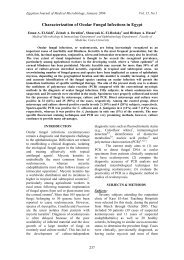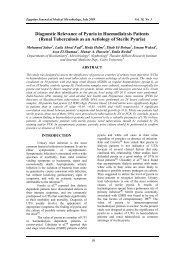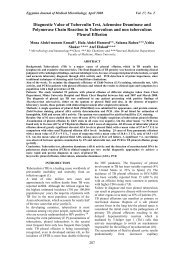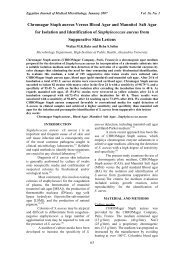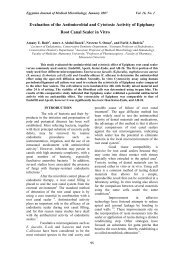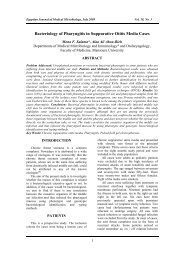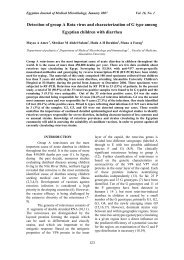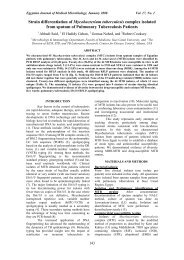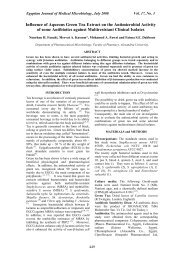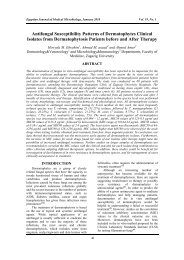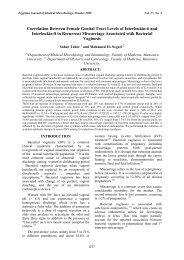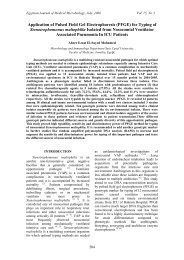Characteristics and Outcome of Patients with Influenza A (H1N1 ...
Characteristics and Outcome of Patients with Influenza A (H1N1 ...
Characteristics and Outcome of Patients with Influenza A (H1N1 ...
You also want an ePaper? Increase the reach of your titles
YUMPU automatically turns print PDFs into web optimized ePapers that Google loves.
Egyptian Journal <strong>of</strong> Medical Microbiology, January 2010 Vol. 19, No. 1No patient was complicated <strong>with</strong> secondarybacterial pneumonia or associated <strong>with</strong>bacteriamia .7 cases <strong>of</strong> influenza <strong>H1N1</strong> were reported innurses due to contact <strong>with</strong> patientsDISCUSSIONSince 2000, the WHO has promptedcountries to prepare for a potential influenzap<strong>and</strong>emic. Activities included the introduction<strong>of</strong> yearly influenza vaccination <strong>and</strong> a strategicreserve <strong>of</strong> oseltamivir, antibiotics, <strong>and</strong>protective items for health care personnel wasestablished in 2006 9 . Since the emergence <strong>of</strong> thenovel <strong>H1N1</strong> influenza 2009 in mid April, thenumber <strong>of</strong> confirmed cases has increased tomillions across the world <strong>with</strong> at least 17000deaths till writing this study 10 .Table 3: <strong>Characteristics</strong> <strong>of</strong> 97 patientsconfirmed <strong>of</strong> <strong>H1N1</strong> infleunza virus.VariablesValueAge years (mean ± SD) 34.5± 16.99Male (No. , %) 52 (53.6%)Female (No. , %) 45 (46.4%)Leucopenia (No. , % ) ( 88 , 91% )Less than 3000/mm 3Median number <strong>of</strong> days (1.5 days ± 0.6)from illness onset toinitiation <strong>of</strong> antiviral ttt(mean ± SD)No. <strong>of</strong> patients receiving 97 (100%)antiviral ttt before testingresults available.Duration <strong>of</strong> oseltamivir tttClinical outcome: (No.,%)CuredDiedTransferredMechanical ventilation(No. , % )- No- YesRange ( 5-10 days)(6 ± 1.8)95 (97.9 %)1 (1.03% )1 (1.03% )95 (97 .9%)2 (2.1%)Most <strong>of</strong> our patients were young to middleaged<strong>and</strong> had previously been healthy. Themajority <strong>of</strong> infections reported have been mild,influenza-like illnesses. This has been reportedin other countries 11,12 .Fever, fatigue <strong>and</strong> respiratory symptomswere harbingers <strong>of</strong> disease in almost all cases inthis study <strong>and</strong> in others 12,13, 14 .The most common comorbidities amongpatients in this study were lung diseases <strong>and</strong> ahistory <strong>of</strong> smoking. This agreed <strong>with</strong> otherstudies 9,12,13 . Also Kumar et al. 12 reported thatamong critically ill patients, obesity has beenshown to be a risk factor for increasedmorbidity, but not consistently <strong>with</strong> mortality.The association <strong>of</strong> obesity <strong>with</strong> severe 2009influenza A (<strong>H1N1</strong>) infection has been reportedby others 13,14,15 , <strong>and</strong> may be a novel finding <strong>of</strong>this p<strong>and</strong>emic.This study has point <strong>of</strong> strength. It includesboth adults <strong>and</strong> children from geographically<strong>and</strong> racially diverse settings across MadinahMonawarha region, which improves thegeneralizability <strong>of</strong> our results to other regions.The tendency <strong>of</strong> females to develop severe2009 influenza A (<strong>H1N1</strong>) infection in this seriesis striking. A general female susceptibility hasnot been observed in other influenza case series<strong>of</strong> variable severity including the initial reports<strong>of</strong> 2009 influenza A (<strong>H1N1</strong>) infections 3 . Inmost infectious diseases <strong>and</strong> related conditionssuch as sepsis <strong>and</strong> septic shock, males representa larger proportion <strong>of</strong> cases <strong>and</strong> have a highermortality 16 . The explanation for increased risk<strong>of</strong> severe disease <strong>and</strong> death among females isunclear but the role <strong>of</strong> pregnancy as a risk factorhas been noted in previous influenzap<strong>and</strong>emics 17 . In spite <strong>of</strong> that the 4 pregnantcases in this study recovered completely <strong>with</strong>outcomplications, maybe due to the earlyintroduction <strong>of</strong> antiviral as recommended byWHO 18 .Padilla et al. 9 reported that false negativetest in patients would be more likely if the testwere delayed (as the 2 cases in this study), or ifpatients had limited viral shedding. Theynoticed that patients who tested negative for<strong>H1N1</strong> had a milder clinical course than thosewho tested positive but were as much a part <strong>of</strong>the burden <strong>of</strong> the epidemic as those who werenot tested.Unusual features <strong>of</strong> severe disease in thecurrent p<strong>and</strong>emic compared <strong>with</strong> most previouswell characterized p<strong>and</strong>emics, including the(probable) H2N2 1890 Russian influenzap<strong>and</strong>emic, the H2N2 1957 Asian influenzap<strong>and</strong>emic, <strong>and</strong> the H3N2 1968 Hong Kongp<strong>and</strong>emic. In these previous influenzap<strong>and</strong>emics, an increased predilection forinfection among children <strong>and</strong> young adults hasbeen documented 19 although mortality curveswere U shaped <strong>with</strong> increased deaths in the veryyoung <strong>and</strong> the aged. Data suggested 12,13 thatsevere disease <strong>and</strong> mortality in the currentoutbreak is concentrated in relatively healthyadolescents <strong>and</strong> adults between the ages <strong>of</strong> 10<strong>and</strong> 60 years, a pattern reminiscent <strong>of</strong> the W-87



